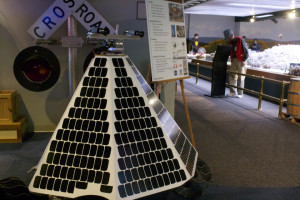
By: Sam Fatula | Asst. A&E Editor
Ever since the United States was the first country to successfully land on the moon’s surface over 40 years ago with Apollo 17, solely NASA has not made the voyage back since.
Untouched for decades, the moon still has many locations that have yet to be explored, resulting in unanswered questions.
Google has taken the initiative, sponsoring a lunar landing competition without the aid of government funds. The competition, called the Google Lunar XPrize, challenges teams from around the world to construct a robotic lunar lander and send it to the moon, where it must travel 500 meters and record its findings. The first team to provide video evidence of traveling 500 meters wins.
The prize? $20 million.
Two of the 18 teams currently involved in the space race are local to the Pennsylvania area. Last Saturday, Carnegie Mellon University affiliate Astrobotic, a combination of students and additional robotic engineers, and Penn State University’s student-lead Lunar Lion team were present at the Carnegie Science Center to discuss developments for both of their projects and to premiere a short, 25-minute film titled Back to the Moon for Good, narrated by Tim Allen.
The fulldome planetarium shows documents and interviews various teams and their involvement with the XPrize. By including nationalities that range from European to South American, the show makes it clear of the growing global emergence towards space travel.
CEO of Astrobotics, John Thornton, introduced the idea of taking a lunar lander into underground tunnels of the moon if his team were to win the XPrize.
“There is a pit on the surface of the moon; 300 feet across, 300 feet deep,” Thornton said. “At the bottom of the pit is an entryway to a lunar cave underneath the surface. At one point the cave was flowing with lava, but it has now cooled leaving tunnels. Our first mission will land next to that so we can peer into it for the very first time and then lay the groundwork.”
Though Penn State’s Lunar Lions don’t have an extensive plan after the XPrize competition is over, team leader Michael Paul hopes that this places the university on the map for future space endeavors.
“We have over 80 students from fields such as engineering, marketing and theater who are adding their energy and education to what we’re doing,” Paul said. “We see this as an entryway for Penn State, which already has strength in space sciences, as a way to become the go-to university for private space exploration.”
Susan Zimecki, director of marketing and community affairs at the Carnegie Science Center, sees promise in the Pennsylvania teams.
“Undoubtedly, these teams are a great inspiration to all the kids and adults who visited today,” Zimecki said. “I hope that there will be tremendous excitement once these teams land on the moon, especially with all of the promise of future exploration based on the robotic and engineering advances.”
While both teams have different plans for their expedition, Paul and Thornton share a similar goal for space exploration.
“What’s really important here is that there are now 30 different entities that have developed plans for landing a spacecraft on the moon that didn’t exist before the prize was announced,” Paul said. “The whole incentive behind the prize is to grow the whole industry, not just to do this one mission.”
Thornton also agrees that the expansion for moon travel is becoming more of a necessity than ever before.
“We want the moon to be as close as the next continent is for the next generation,” Thornton said. “The prize for us is just the beginning. We’re out to create a recurring business of flying to the surface of the moon and creating this transportation opportunity.”
Both the Lunar Lions and Astrobotic plan to launch their lunar rovers in Florida between October and December 2015. The deadline launch for all teams is Dec. 31, 2015.

